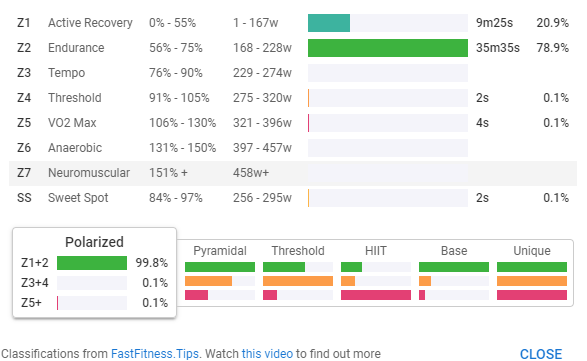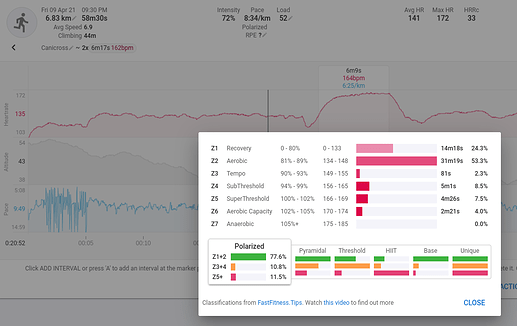Another data point of an issue I noticed today. Did a mini mini accidental sprint in the middle of a Z2 ride, ICU marked it as “Polarized”. Didn’t know it’s that easy to do polarized training 
I realize these are probably quite annoying to code right when you get to edge cases. 
I’ve always thought that the distribution chart should only be relevant to the date range selected at the top.
The fact it shows the latest workout is rather confusing. I would simply remove the last workout display and link it to the selected date range.
The distribution chart is totally meaningless per workout. It’s really only useful for extended training periods.
For example, there is no such thing as a ‘polarized workout’. Polarized training is time in zone over an extended period. Weeks, months etc.
This needs a re-think.
Ok, help me here please. I am new to Intervals.icu. i have a few newbie questions (Sorry, but i was not sure how to put in meaningful searches to find the answers)
-
I was looking at the Totals page, and trying to work out what the actuak ratios of each time in zone are that determine whether the classification is Pyrimid, Threshold, Polarized or whatever. Watching the FFT video did not help because that was still talking about days and not time in zone. Also it did not clarify the precise lines between each type. That was the start of this search.
-
@ David Your post above provide a set or rules, which i can make sense of, so thank you. @Chad_McNeese are these rules consistent with what Amber describes in her excellent video (299 I think), when she described the research and variety of definitions of the various mixes of training zones?
-
Does this classification apply to the Date range chosen above? I assumed it does because changing teh date range can change the classification. However @The_bandit says it is only the most recent ride (which seems pretty pointless)
-
I asked (3) because the @niklas post says he saw a ride classified by intervals.icu. I have looked at my rides and see no such classification? How do I see that? (Do I use this same Totals. but simply zone it down to a single day?
Thanks in advance for help to a Newbie 
There is some more info in this thread:
https://forum.intervals.icu/t/mapping-7-zone-to-3-zone-model-wrt-polarized-training/3090/51
Your 4th point:

Click on “Polarized” or whatever classification shown in the activity page to bring up this:
Welcome!
Yes it does apply to the whole date range selected. If you click options and turn on “Show watts” and/or “Show HR” the the watts and/or HR numbers shown on the chart are from the zones for the most recent activity in the date range. You zones may well have changed during the time period. Each activity gets its own copy of the zones with time in each zone etc… So the totals are good, it’s just the watts/bpm numbers that reflect the most recent activity.
@david - there’s still a bug with how TiZ is classified:
I’ve seen a few examples of other people getting confused with the classifications as well (in discussions on the TrainerRoad forum etc.).
As posted last year, from looking the code snippet you posted I think the fix could be as simple as correcting the logic for the Pyramidal check:
Hmm. It doesn’t help that there are no “standard” definitions for the training distributions. If your s1 is very much more than s2 are you really doing pyramidal? I could tweak it a bit. Any suggestions?
I think the biggest problem at the moment is that the more Z1+Z2 you do, the more likely it is to classify it as Threshold (which can’t be right):


I’d personally say a split of 74.5% / 21.7% / 3.8% should be either classified as Base or Pyramidal, but definitely not Threshold.
I’m not sure what the exact thresholds should be between the different classifications, but fixing the Pyramidal logic would improve it.
Ok I have tweaked it a bit:
if (s3 > s2 && s3 > 0.499 * (s2 + s1)) ans = HITT
else if (s3 > s2 && s1 > s2) ans = POLARIZED
else if (s1 > 3.99 * s2 && s1 > 3 * (s2 + s3)) ans = BASE
else if (s1 > 1.4 * s2 && s2 > 1.4 * s3 && (s3 /all) >= 0.05) ans = PYRAMIDAL
else if (s1 < 4 * s2 && s2 > 0.5 * s3) ans = THRESHOLD
else ans = UNIQUE
So for PYRAMIDAL s3 must be at least 5% of the total and each easier zone at least 1.4 x the one below it. Looking at my own data this did convert some threshold classifications into pyramidal, correctly IMO.
Has the change been deployed?
Yes but you might need to reload the app to see it.
Thats because of the 3.8% in Z5+. That needs to be at least 5% with the new formula. I could drop that to 3% …
I Googled a bit more and found this: Polarized and Pyramidal Training Intensity Distribution: Rel
Therefore, the aim of the present study is to relate training intensity distribution with performance during a Half-Ironman race in two groups that followed two different training intensity distributions: “polarized” 84.4% / 4.3% / 11.2% distribution and “pyramidal” 77.9% / 18.8% / 3.3% distribution of total training time for zones 1,2 and 3, respectively.
So maybe 3% is good. I will change it quick …
Just done some testing with it and its looking much better now.
There’s still this case though, where Z5+ < 3%:
I’d say with 72.9% in Z1+2 it should be classed as Base, rather than Threshold.
Hey guys,
I found this interesting debate, and I hope you can clarify a question for me that I have on the same issue. I read this thread thoroughly but did not find an answer yet. So please forgive me if I am missing anything. My question is rather simple, and I hope there is a simple question too.
If my overall training of, say, one season is looked at in intervals.icu, will the classification as “Polarized”, “Threshold”, or “HIIT” be based purely on time spent in zones? Or will the classification be based on the actual purpose of my training sessions?
From your shared code @david I cannot tell if it’s time-based or session-based what the classification is relying on.
One example. If I purely do HIIT sessions, I will still accumulate much more time in Zone 1 (because a typical HITT session is much about coasting along until the next hard but short effort) than in Zone 5 or 6. So If I was looking at time spent in zones, my training is likely to look “polarized” when it is actually HIIT only.
I hope you can answer my question, and I wold very much appreciate a rather simple answer to it.
Keep up all the excellent work @david .
It’s classified based on time in zone.
As you rightly say, the purpose of a session might be HIIT, eg. 4-10 sets of 30s all out efforts, with 8 minutes rest in between. The goal then might result in 10/10 on the RPE scale, as it is only the 30s efforts that count and not 5/10 (challenging).
Thank you very much @Gerald for clarifying on this. I must admit, that I hoped for another answer, because of from what I understand, the classification should be based on session count, not on time spent in zones. But maybe I get the whole 80/20 idea of Seiler wrong? Please correct me then.
But I do understand that it would take a lot of additional effort to program an algorithm detecting what purpose any training session serves. But maybe that is worth thinking about?
Dr Seiler’s classifying of sessions is based on count, so you do understand it correctly. He has also stated that if it’s TIZ based, then it’s closer to 90/10.
Use the calendar (ACTIVITIES page) to plan your hard and easy workouts based on sessions and let the time in zone just fall into place.
All my short, medium and long term planning is all structured around basic principles of training. Adjustments (fine tuning) is then done based on how life happens. The planning always starts with the known requirements for the week/block coming up, and the balance is filled in to top up the volume/intensity.
Thanks again for your knowledgeable answer, @Gerald . I do not use the tool to plan my workouts but to monitor what I do on the bike. I use Wahoo SYSTM training plans most of the time and made good progress in the past. The overall training is categorized as “Pyramidal,” which seems to be what the Wahoo guys aim to do. So all good from my perspective.
Anyway, for the upcoming winter, I plan to give “Threshold” another shot, but that’s another topic.



